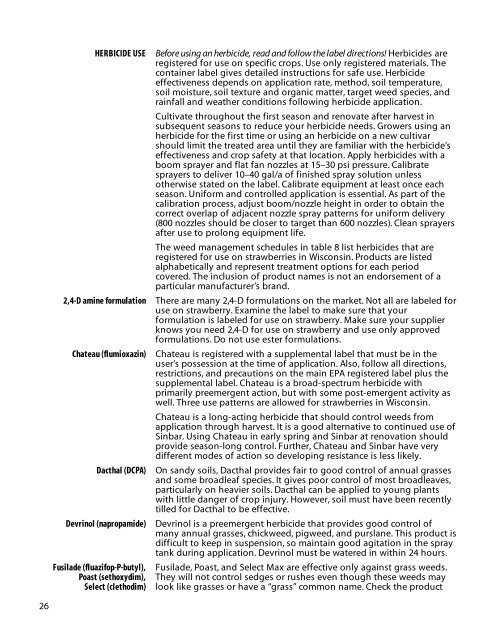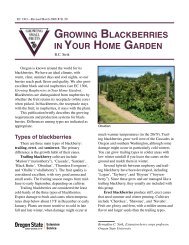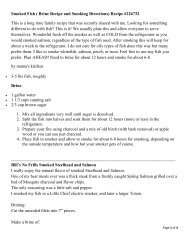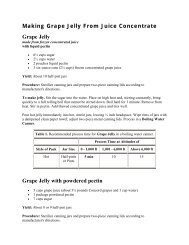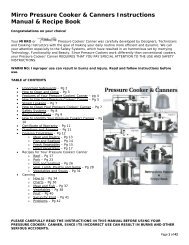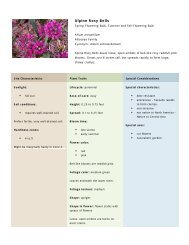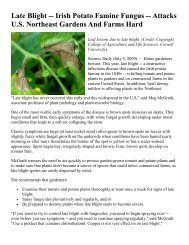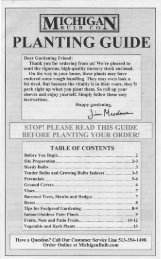Strawberry and Raspberry Pest Management in Wisconsin
Strawberry and Raspberry Pest Management in Wisconsin
Strawberry and Raspberry Pest Management in Wisconsin
You also want an ePaper? Increase the reach of your titles
YUMPU automatically turns print PDFs into web optimized ePapers that Google loves.
26<br />
HERBICIDE USE Before us<strong>in</strong>g an herbicide, read <strong>and</strong> follow the label directions! Herbicides are<br />
registered for use on specific crops. Use only registered materials. The<br />
conta<strong>in</strong>er label gives detailed <strong>in</strong>structions for safe use. Herbicide<br />
effectiveness depends on application rate, method, soil temperature,<br />
soil moisture, soil texture <strong>and</strong> organic matter, target weed species, <strong>and</strong><br />
ra<strong>in</strong>fall <strong>and</strong> weather conditions follow<strong>in</strong>g herbicide application.<br />
Cultivate throughout the first season <strong>and</strong> renovate after harvest <strong>in</strong><br />
subsequent seasons to reduce your herbicide needs. Growers us<strong>in</strong>g an<br />
herbicide for the first time or us<strong>in</strong>g an herbicide on a new cultivar<br />
should limit the treated area until they are familiar with the herbicide’s<br />
effectiveness <strong>and</strong> crop safety at that location. Apply herbicides with a<br />
boom sprayer <strong>and</strong> flat fan nozzles at 15–30 psi pressure. Calibrate<br />
sprayers to deliver 10–40 gal/a of f<strong>in</strong>ished spray solution unless<br />
otherwise stated on the label. Calibrate equipment at least once each<br />
season. Uniform <strong>and</strong> controlled application is essential. As part of the<br />
calibration process, adjust boom/nozzle height <strong>in</strong> order to obta<strong>in</strong> the<br />
correct overlap of adjacent nozzle spray patterns for uniform delivery<br />
(800 nozzles should be closer to target than 600 nozzles). Clean sprayers<br />
after use to prolong equipment life.<br />
The weed management schedules <strong>in</strong> table 8 list herbicides that are<br />
registered for use on strawberries <strong>in</strong> Wiscons<strong>in</strong>. Products are listed<br />
alphabetically <strong>and</strong> represent treatment options for each period<br />
covered. The <strong>in</strong>clusion of product names is not an endorsement of a<br />
particular manufacturer’s br<strong>and</strong>.<br />
2,4-D am<strong>in</strong>e formulation There are many 2,4-D formulations on the market. Not all are labeled for<br />
use on strawberry. Exam<strong>in</strong>e the label to make sure that your<br />
formulation is labeled for use on strawberry. Make sure your supplier<br />
knows you need 2,4-D for use on strawberry <strong>and</strong> use only approved<br />
formulations. Do not use ester formulations.<br />
Chateau (flumioxaz<strong>in</strong>) Chateau is registered with a supplemental label that must be <strong>in</strong> the<br />
user’s possession at the time of application. Also, follow all directions,<br />
restrictions, <strong>and</strong> precautions on the ma<strong>in</strong> EPA registered label plus the<br />
supplemental label. Chateau is a broad-spectrum herbicide with<br />
primarily preemergent action, but with some post-emergent activity as<br />
well. Three use patterns are allowed for strawberries <strong>in</strong> Wiscons<strong>in</strong>.<br />
Chateau is a long-act<strong>in</strong>g herbicide that should control weeds from<br />
application through harvest. It is a good alternative to cont<strong>in</strong>ued use of<br />
S<strong>in</strong>bar. Us<strong>in</strong>g Chateau <strong>in</strong> early spr<strong>in</strong>g <strong>and</strong> S<strong>in</strong>bar at renovation should<br />
provide season-long control. Further, Chateau <strong>and</strong> S<strong>in</strong>bar have very<br />
different modes of action so develop<strong>in</strong>g resistance is less likely.<br />
Dacthal (DCPA) On s<strong>and</strong>y soils, Dacthal provides fair to good control of annual grasses<br />
<strong>and</strong> some broadleaf species. It gives poor control of most broadleaves,<br />
particularly on heavier soils. Dacthal can be applied to young plants<br />
with little danger of crop <strong>in</strong>jury. However, soil must have been recently<br />
tilled for Dacthal to be effective.<br />
Devr<strong>in</strong>ol (napropamide) Devr<strong>in</strong>ol is a preemergent herbicide that provides good control of<br />
many annual grasses, chickweed, pigweed, <strong>and</strong> purslane. This product is<br />
difficult to keep <strong>in</strong> suspension, so ma<strong>in</strong>ta<strong>in</strong> good agitation <strong>in</strong> the spray<br />
tank dur<strong>in</strong>g application. Devr<strong>in</strong>ol must be watered <strong>in</strong> with<strong>in</strong> 24 hours.<br />
Fusilade (fluazifop-P-butyl),<br />
Poast (sethoxydim),<br />
Select (clethodim)<br />
Fusilade, Poast, <strong>and</strong> Select Max are effective only aga<strong>in</strong>st grass weeds.<br />
They will not control sedges or rushes even though these weeds may<br />
look like grasses or have a “grass” common name. Check the product


